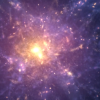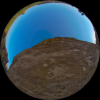Astrophysical and Planetary Sciences
 Solar wind and radiation are responsible for stripping the Martian atmosphere, transforming Mars from a planet that could have supported life billions of years ago into a frigid desert world.
Solar wind and radiation are responsible for stripping the Martian atmosphere, transforming Mars from a planet that could have supported life billions of years ago into a frigid desert world. A team of astronomers, including one from CU Boulder, used the super-sharp radio vision of the National Science Foundation's Very Long Baseline Array (VLBA) to find the shredded remains of a galaxy that passed through a larger galaxy, leaving only the smaller galaxy's nearly-naked supermassive black hole to emerge and speed away at more than 2,000 miles per second.
A team of astronomers, including one from CU Boulder, used the super-sharp radio vision of the National Science Foundation's Very Long Baseline Array (VLBA) to find the shredded remains of a galaxy that passed through a larger galaxy, leaving only the smaller galaxy's nearly-naked supermassive black hole to emerge and speed away at more than 2,000 miles per second. Having captured the summer solstice and a week’s worth of sunsets, sunrises and their lunar equivalents from the vantage point of ancient Chacoan people in southwestern Colorado, using parabolic video technology, a multi-disciplinary team from the University of Colorado Boulder counted its June 2015 trip a success.
Having captured the summer solstice and a week’s worth of sunsets, sunrises and their lunar equivalents from the vantage point of ancient Chacoan people in southwestern Colorado, using parabolic video technology, a multi-disciplinary team from the University of Colorado Boulder counted its June 2015 trip a success.

